
501(c)7 non-profit
Join Us!
About
Club History
Authors
Training
Syllabus
Documents
Directions
Events
Newsletter
Current
Previous
Duty Roster
Snapshots
Videos
Links
Region IV
OLC
Weather
|
Members-Only |
Skyline Soaring Club Training Syllabus
The Complete Skyline Soaring Syllabus is also available in:- PDF Format
- Full Syllabus (One page)
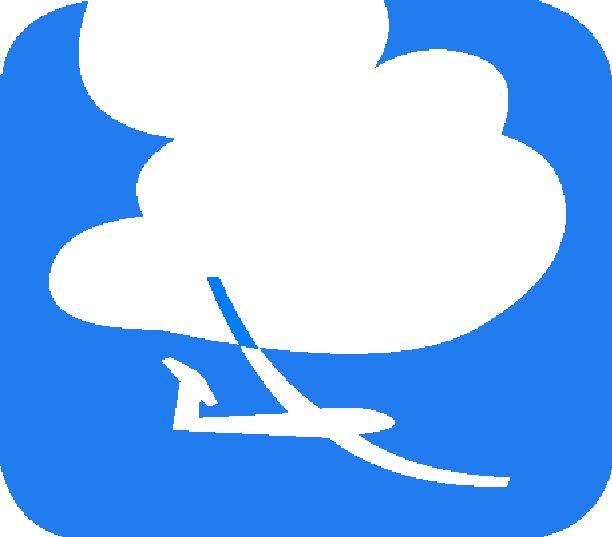
Skyline Soaring Club, LLC.
Skyline Soaring Club Training Syllabus
The use of this training syllabus is intended for the instructors, students and members of Skyline Soaring Club, Inc; located in Front Royal Virginia. Other commercial or non-profit organizations and instructors may also use this material - see sections on "License and Restrictions" and "Using the Training Syllabus on Paper" under the heading "Non-Skyline Instructor Use"
Flight Instructors, web masters and authors outside of Skyline Soaring Club are welcome to use any or all of Skyline Soaring Club's training materials contained in this document, as they see fit, free of charge from Skyline Soaring Club, provided the conditions are met under the Creative Commons License version 3.0. Full details about this license can be found at the following URL: http://creativecommons.org/licenses/by/3.0/us/
Chief Flight Instructor: John Noss
Revised: 24 February 2025
The contents of this syllabus is the result of collaborative efforts of the Certified Flight Instructors for Skyline Soaring Club, Inc; operating out of Front Royal, VA. Feedback or corrections for the Skyline Soaring Training Syllabus can be sent to the Chief Flight Instructor, John Noss. john@noss.ws . Feedback is welcome, especially for suggestions on external links.
The training syllabus is a living document. Clubs that use the syllabus are strongly encouraged to subscribe to the Skyline Syllabus Mailing List. Any updates to the contents of the syllabus are automatically mailed as the changes are made. To subscribe, visit the website https://members.skylinesoaring.org/mailman/listinfo/syllabus . Nobody is permitted to send mail to that mailing list except for the site administrator, and only when updates are made to the training syllabus.
License and Restrictions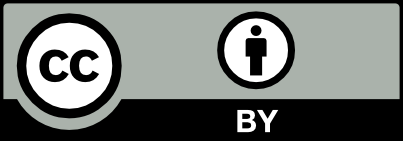
You are free:
- to Share - to copy, distribute and transmit the work
- to Remix - to adapt the work
- Permissions beyond the scope of this public license are available at https://members.skylinesoaring.org
Under the following conditions:
- Attribution - You must attribute this work to The Skyline Soaring Club
With the understanding that:
- Waiver - Any of the above conditions can be waived if you get permission from the copyright holder.
Other Rights - In no way are any of the following rights affected by the license:
- Your fair dealing or fair use rights;
- Apart from the remix rights granted under this license, the author's moral rights;
- Rights other persons may have either in the work itself or in how the work is used, such as publicity or privacy rights.
Notice - For any reuse or distribution, you must make clear to others the license terms of this work. The best way to do this is with a link to http://creativecommons.org/licenses/by/3.0/us/
Syllabus Usage (General)
Transition Pilots
Pilots already possessing an FAA Rating, but for a different category, (such as Airplane, Single Engine Land, Rotorcraft, Lighter-Than-Air, etc.), are NOT considered by the FAA as a "student pilot." This pilot is a rated pilot seeking to add a new category rating. However, as far as Skyline Soaring Club's program is concerned, the flight instructors will regard this candidate identically to an unrated student pilot. The transition pilot will be put through the same program that an ab-initio pilot would receive. The transition pilot will probably go through the training program much more quickly, but the Skyline Instructors must verify that the candidate meets or exceeds all of the requirements that a first-solo § 61.87 student would before his first solo (including the pre-solo written test). Upon completion of the training program, the transition pilot will receive a § 61.31(d)(2) endorsement (see also AC 61-65J ¶ A.72), and not a § 61.87 endorsement, like a student pilot would.
New Pilots (Starting from Scratch)
The Training Syllabus covers all of the required areas that are specified in 14 CFR § 61.87. Each lesson plan is a sample of what is to come. In each lesson plan is a section of required reading. It is understood that the student will have read each of the items in the required reading section before coming to fly with the instructor. Failure to do reading assignments ahead of time is a consistent and reliable indicator of delayed progress. Delayed progress adds unnecessary personal expense to complete the training program.
Syllabus Usage (Skyline Instructors)
Using the On-line Student Progress Report
Skyline Soaring Club stores all of the records about a student's flight training record electronically. There is no need to print the forms at the end of this document, except for reference. After the flight instruction session, the instructor will automatically be notified by e-mail of any recent flights with his students. The instructor will score the flights as appropriate, scoring each section with a score 1 through 3. A score of "1" indicates that the content was introduced. A score of "2" indicates that the student performed the maneuver or procedure. A score of "3" indicates that the candidate has performed the maneuver or procedure to the solo standards stated in the appropriate lesson plan. Scores of "4" are reserved for post-solo students directly training for their Private Pilot Practical Test.

Flights where there is significant need to address problem areas on the next flight are marked with a red exclamation point. This is not meant as a failure, but rather as an urgent indicator to the next instructor that this is an area that needs focus and attention. Once the instructor completes his report, he will be given an opportunity to write an optional essay describing details of the lesson session.
The completed lesson report is mailed to the Skyline Soaring Club instructors, as well as the student for future review and planning. The student may view his progress page at any time, and get a clear indication of what lesson segments are still required before solo flight is considered.
Syllabus Use (Non-Skyline Instructors)
Using the Training Syllabus on Paper
For non-Skyline instructors, tracking a student's progress can be done by the two forms at the end of this document.
Use the Training Syllabus Tracking Sheet to keep track of which instructors have signed off a particular section as demonstrated at solo quality. When the student has completed all areas listed as required for solo flight, the instructor and student will sign the end of the document, indicating that all instruction has been given to the satisfaction of the student.
Use the Flight Progress Tracking Sheet to track individual flights. Multiple copies of these two pages will be necessary to fully document the flight record of the student. At the right-most column of this sheet, indicate the maximum score achieved for each lesson segment. In the following example, Frank Schüler has had a total of 11 flights with 6 different instructors (which can often happen in a club environment). Each instructor gave a score of 1, 2, or 3 depending on the student's progress.
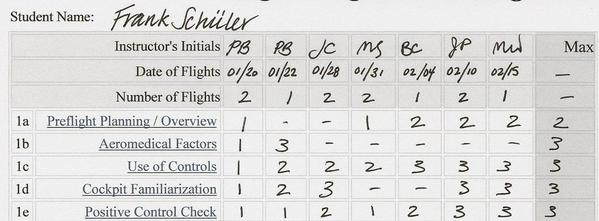
Student solo is not permitted until a score of "3" has been documented and achieved for all sections listed as required for solo flight. Refer to the Training Syllabus Tracking Sheet for a list of all sections required for student solo. Once all of the appropriate sections have been demonstrated at the solo proficiency level or higher, both the student and instructor will sign the affirmation statement. This statement can be found at the end of the Training Syllabus Tracking Sheet. This indicates that both the instructor and student have successfully accomplished the full training program, and that it has been completed to their satisfaction. The instructor will keep the original signed document, and prepare a copy for the student to keep for his or her own record keeping.
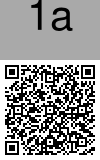
Using QR Codes
Each section in the printed version of the training syllabus contains a QRcode. The QR code is located in the upper right hand corner of each section of the syllabus (also shown here). These QR codes are included as a convenience for smart-phone equipped instructors or students who are using a printed copy of the syllabus, and are not near an Internet connected computer. While using a smart phone with a QR code reader, the savvy instructor or student can pull up the online copy of that particular page of the syllabus. Use this to follow any hyperlinks or videos that the lesson plan may include.
FAA WINGS Credits
The Federal Aviation Administration sponsors a continuing training program called WINGS. All members of the Skyline Soaring Club are required to have completed the Special Airspace training required by 91.161. This training is accomplished by completing a 1/2 credit course in WINGS. Therefore, all members of the club should have a WINGS account.
Many of the training items in this syllabus closely correlate to flight topics in the FAA WINGS Pilot Proficiency Program. When performing currency flights, you may use these two charts to determine which flight activities in the syllabus are required for the FAA WINGS flight activities.
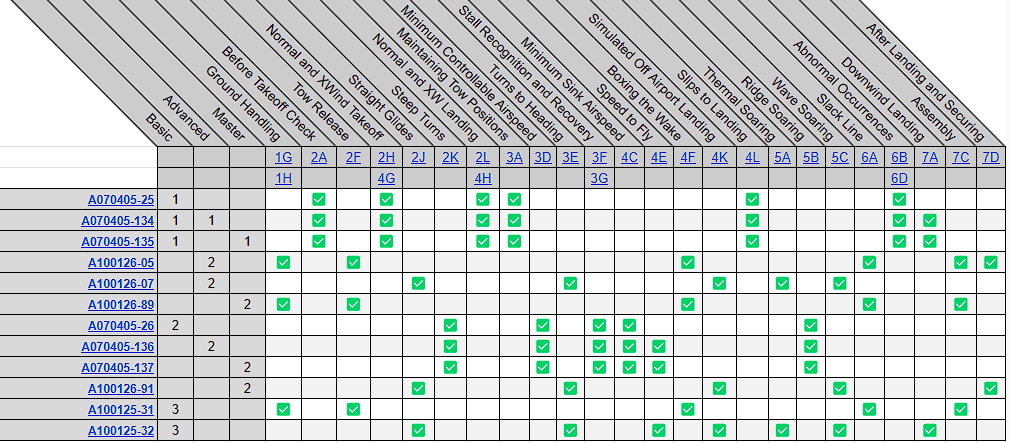
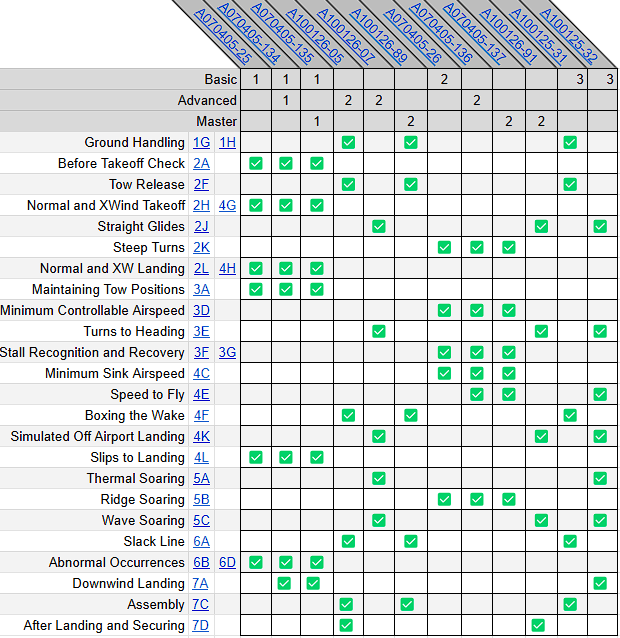
Materials List
Before or immediately after your first lesson
|
Glider Pilot Logbook Soaring Society of America |
 |
Before or immediately after the first lesson, the student must have a Pilot Logbook. The Glider Pilot logbook is generally given to the student as a part of the FAST package. The logbook can also be purchased from the club, or purchased online from the Soaring Society of America for a modest price. Your instructor is required to legibly record any flight and ground instruction in your log book, so it is required to be with you each time you have a lesson at the club. |
|
Glider Flying Handbook FAA |
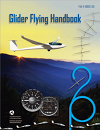 |
This book is published by the Federal Aviation Administration. It is considered public domain. In electronic form, this book is available for free. The FAA publishes the entire book as a low resolution PDF, or as higher resolution versions by each chapter. Get the latest electronic version of the GFH by going to https://www.faa.gov/regulations_policies/handbooks_manuals/aviation/glider_handbook/ . Many of the lesson plans included in this syllabus reference certain pages in this book. You can purchase a copy of this book from the Soaring Society of America for $32.00. |
|
Pilots Handbook of Aeronautical Knowledge FAA |
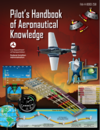 |
This book is published by the Federal Aviation Administration. It is considered public domain. In electronic form, this book is available for free. This book focuses on flying airplanes. This book is included as a resource for soaring mainly because some key subjects are not adequately covered in the Glider Flying Handbook. It is not recommended that you purchase this book. Lesson plans in this training syllabus that include topics only covered in the Pilot Handbook of Aeronautical Knowledge link directly to the appropriate chapter. You are not expected to purchase this book, but you may find it a handy reference for many topics in aviation. |
Pre-Solo Materials
Student Pilot License: As you near your first solo, you will need a student pilot's certificate. If you are already a rated pilot seeking an additional category glider rating, your pilot's license will suffice. Since 1 April 2016, all student pilots must go through a TSA background check. Begin the process for getting a student pilot certificate by signing up with the FAA's Integrated Airman Certification and Rating Application (IACRA) at https://iacra.faa.gov/IACRA/Default.aspx .
FAR/AIM As you progress through the training program, it is highly recommended that you own a copy of the FAR/AIM. All of the regulations are online and linked throughout this syllabus, but you should still have the book for ready reference and reading.
- The latest version of the Aeronautical Information Manual is available at: https://www.faa.gov/air_traffic/publications/#manuals
- The FAA Regulations related to obtaining and keeping a pilot certificate are contained in part 61.
- The latest versions of the Federal Regulations related to flight rules are contained in part 91.
Local Sectional Chart You must be familiar with the airspace around our airport. There are some very complicated and dangerous airspaces near to our field, and owning a sectional is an important step toward understanding the airspace and air traffic in our area. You may use on-line sectional tools such as skyvector.com, but you may not use those charts for in-flight navigation. There are two sectional charts for our area. The Washington Sectional covers the airspace to the east and south of our base of operations. The Cincinnatti chart covers the areas to the west. These charts can be purchased at our FBO, or on-line. The FAA provides an excellent resource on how to read aeronautical charts in the 12th edition of the Chart Users Guide.
FAA Knowledge Exam Materials
If this is your first pilot rating, or if this is your first pilot rating at the Private Pilot level, you will need to complete a knowledge test, administered by the FAA. If you already have a Private Pilot rating for any powered aircraft, you are not required to pass the FAA knowledge exam for gliders. Please see the FAA's general information about the knowledge tests (https://www.faa.gov/pilots/testing/).
It is strongly recommended that pilots who are nearing their first solo should have their FAA knowledge test taken and passed before or immediately following their first solo. Any delays in taking the knowledge test can severly impact the student's progress toward a rating.
There are two paths to passing the knowledge exam. The most effective technique is to enroll in a training course that focuses on the private pilot knowledge exam for gliders. If no such training course exists in your area, you may do a home-study course. If you are going through with the home-study course, please follow these recommended actions.
- Read all of the training materials listed above
- The FAA GFH
- The FAR and AIM
- Use a book or software specifically designed for the FAA Knowledge Test
- Dauntless Software has an excellent written test preparation program that runs on your iPad, iPhone, or PC computer
- ASA Test Prep (http://www.asa2fly.com), (includes tablet and computer software testing programs)
- FAA's list of sample test questions, or
- Glider Pilot Ground School (http://www.gliderpilotsgroundschool.com/gpgs-faa-exam-books.html)
Once you have studied the material and are comfortable with the contents, have a Skyline Soaring Club instructor endorse you to take the written test. Find an FAA-approved Testing center with this FAA document: https://www.faa.gov/training_testing/testing . Most testing centers usually charge around $150 to take the written test.
FAA Practical Test Preparation
The practical test is the culmination of all that you have learned during the training process -- both they activity of flying along with the knowledge required by the FAA to be a safe airman. One way to make sure that all topics are covered during the study process is to use a test prep book specifically tailored toward the glider pilot practical test. Bob Wander's 'Made Easy' books cover this very well. There are separate books preparing the Private Pilot candidate and Commercial Pilot candidates.
| Lesson | Phase | FAR Requirement | PTS Area | Instructor Sign-Off and Date |
| 1 | Before We Fly | |||
| 1a | Preflight Planning / Overview | 61.87(i)(1) | 61.107(b)(6)(i),(ii) | |
| 1b | Aeromedical Factors Discussion | I(E) | ||
| 1c | Use of Controls | |||
| 1d | Cockpit Familiarization | |||
| 1e | Positive Control Check | 61.87(i)(1) | II(C) | |
| 1f | Release Mechanisms | 61.87(i)(1) | II(C) | |
| 1g | Handling - Hangar to Flightline | 61.87(i)(2) | II(B) | |
| 1h | Handling - Flightline to Hangar | 61.87(i)(2) | 61.107(b)(6)(xi) | |
| 2 | First Flights | |||
| 2a | Pre Takeoff Checklist | 61.87(i)(1) | IV(A) | |
| 2b | Attitude Flying / Scanning | 61.87(i)(6) | ||
| 2c | Glider Daily Inspection | 61.87(i)(1) | I, II(C) | |
| 2d | Airport Procedures | 61.87(i)(5) | 61.107(b)(6)(iii) | |
| 2e | Cockpit Management | II(D) | ||
| 2f | Aerotow Release | 61.87(i)(11) | IV(F) | |
| 2g | Visual Signals | 61.87(i)(11) | II(E) | |
| 2h | Normal Takeoff | 61.87(i)(3) | IV(B) | |
| 2i | Normal Aerotow | 61.87(i)(12) | IV(C) | |
| 2j | Straight Glide | 61.87(i)(4) | VII(A) | |
| 2k | Shallow, Medium, Steep Turns | 61.87(i)(4) | VII(C) | |
| 2l | Normal Landing | 61.87(i)(16) | 61.107(b)(6)(iv) | |
| 3 | Core Flights | |||
| 3a | Hi-Low Tow Transition | 61.87(i)(12) | IV(C) | |
| 3b | Before-landing Checklist | 61.87(i)(16) | IV(Q)(8) | |
| 3c | Traffic Pattern | 61.87(i)(10,16) | IV(Q) | |
| 3d | Minimum Controllable Airspeed | 61.87(i)(8) | V(A), IX(A) | |
| 3e | Turns to Heading | VII(B) | ||
| 3f | Forward Stall, with and without airbrakes | 61.87(i)(14) | 61.107(b)(6)(ix) | |
| 3g | Turning Stall, with and without airbrakes | 61.87(i)(14) | 61.107(b)(6)(ix) | |
| 3h | Spirals, Descents | 61.87(i)(15) | ||
| 3i | Navigation | 61.107(b)(6)(viii) | ||
| 4 | Advanced Skills | |||
| 4a | Collision, Windshear & Wake Turbulence Avoidance | 61.87(i)(6) | IV(G) | |
| 4b | Radio Procedures | III(A) | ||
| 4c | Minimum Sink | 61.87(i)(8) | V(A) | |
| 4d | Slips: Forward, Side, Turning | 61.87(i)(7) | IV(R) | |
| 4e | Best L/D; Speed-to-fly | 61.87(i)(8) | 61.107(b)(6)(vii) | |
| 4f | Boxing the Wake | 61.87(i)(12) | IV(E) | |
| 4g | Crosswind Takeoff | 61.87(i)(3) | IV(B) | |
| 4h | Crosswind Landing | 61.87(i)(16) | IV(Q) | |
| 4i | Unassisted Takeoff | |||
| 4j | Covered Instrument Landings | 61.87(i)(9) | X(A) | |
| 4k | Precision Landings and Stops | 61.87(i)(16) | X(A) | |
| 4l | Slips to Landing | 61.87(i)(17) | IV(R) | |
| 5 | Soaring Techniques | |||
| 5a | Thermal | 61.87(i)(18) | 61.107(b)(6)(vi) | |
| 5b | Ridge | VI(B) | ||
| 5c | Wave | VI(C) | ||
| 6 | Unusual Attitudes and Emergencies | |||
| 6a | Slack Line | 61.87(i)(9),(19) | IV(D) | |
| 6b | Aerotow Emergency Procedures | 61.87(i)(9),(19) | 61.107(b)(6)(x) | |
| 6c | V-Speeds | 61.87(i)(8) | 61.107(b)(6)(v) | |
| 6d | Rope Breaks | 61.87(i)(9),(19) | 61.107(b)(6)(x) | |
| 6e | Pilot-Induced Oscillations | |||
| 7 | Finishing Touches | |||
| 7a | Downwind Landing | 61.87(i)(16) | IV(S) | |
| 7b | Taxiing and Clearing Runway | 61.87(i)(2) | XI | |
| 7c | Assembly | 61.87(i)(13) | II(A) | |
| 7d | Postflight Inspection | 61.107(b)(6)(xi) | ||
| 7e | Disassembly | 61.87(i)(13) | ||
| 7f | Pre-Solo Written Test | 61.87(b) | ||
| 7g | Special Awareness Training | 91.161 | 91.161 | |
| 7h | Checkride Rating Endorsement | PTS p5 | ||
| 8 | Solo and Badges | |||
| 8a | First Solo and the A Badge | |||
| 8b | The B Badge | |||
| 8c | The C Badge | |||
| 8d | The Bronze Badge | |||
| 9 | Continuing Training | |||
| 9a | Proficiency or Stage Check | |||
| 9b | Flight Review |
I affirm that I, __________________________________________________, have received satisfactory and complete instruction for solo flight, including all applicable topics listed above, and as also as defined in 14 CFR 61.87(i), 61.107(a), and 61.107(b). Student's Signature, _____________________________________, Date ____________ Instructor's Signature, ____________________________________Date ____________.